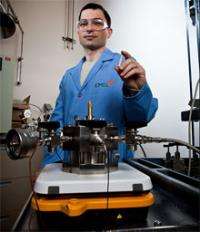New technology enables molecular-level insight into carbon sequestration

Carbon sequestration is a potential solution for reducing greenhouse gases that contribute to climate change, but its scientific challenges are complex. Analytical tools are needed that provide information about the mineral-fluid interactions of carbon dioxide (CO2) at the molecular level.
As part of Pacific Northwest National Laboratory (PNNL)'s Carbon Sequestration Initiative, a team of EMSL and PNNL researchers developed and patented such a tool—a unique high-pressure magic angle spinning (MAS) nuclear magnetic resonance (NMR) capability that operates in conditions characteristic of geologic carbon sequestration.
Described in the September 2011 issue of the Journal of Magnetic Resonance, this new technology consists of a reusable high-pressure MAS rotor, a high-pressure rotor loading/reaction chamber for in situ sealing and reopening of the high-pressure MAS rotor, and a MAS probe with a localized radiofrequency coil for background signal suppression.
This new capability can help determine reaction intermediates and final products that occur during mineral dissolution reactions relevant to the geologic disposal of CO2, as these researchers reported in the July 2011 issue of the International Journal of Greenhouse Gas Control.
Identifying reaction intermediates is not possible using only ex situ measurements and is critical to determining the mechanisms of mineral dissolution at high pressures. This new capability has the potential to further the exploration of solid-state chemistry at new levels of high pressure and temperature in many science areas.
More information: References: Hoyt DW, RVF Turcu, JA Sears, KM Rosso, SD Burton, AR Felmy, and JZ Hu. 2011. “High-pressure Magic Angle Spinning Nuclear Magnetic Resonance,” Journal of Magnetic Resonance, DOI:10.1016/j.jmr.2011.07.019
Hoyt DW, JA Sears, RVF Turcu, KM Rosso, and JZ Hu. 2011. U.S. Patent submission E-16894, “Devices and Process for High-Pressure Magic Angle Spinning Nuclear Magnetic Resonance,” filed July 28, 2011 (provisional patent submitted December 13, 2010).
Kwak JH, JZ Hu, RVF Turcu, KM Rosso, ES Ilton, C Wang, JA Sears, MH Engelhard, AR Felmy, and DW Hoyt. 2011. "The Role of H2O in the Carbonation of Forsterite in Supercritical CO2." International Journal of Greenhouse Gas Control 5:1081-1092.
Provided by Environmental Molecular Sciences Laboratory
















